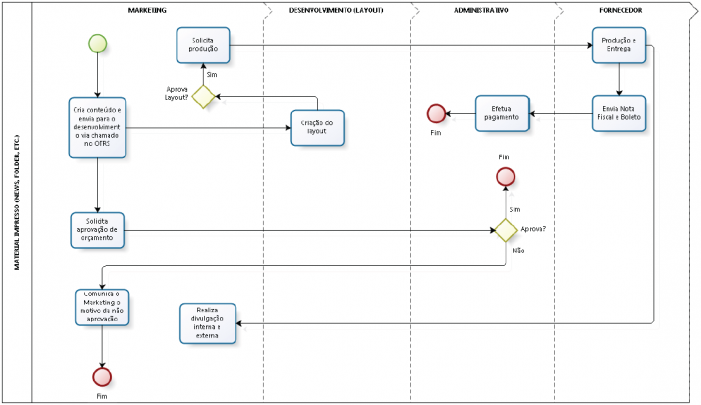BPMN: Business Process Model and Notation

A evolução do meio corporativo e a globalização proporcionaram a estruturação de negócios cada vez mais complexos e abrangentes, divididos em setores e ramificações. Definir o modelo de trabalho das corporações pode não ser uma tarefa fácil, pois é necessário apresentá-lo aos colaboradores e demais integrantes que não estão habituados aos termos técnicos, processos e atividades. A modelagem de processos de negócios com o BPM define, torna possível e gerencia a troca de informações nas organizações através da visão semântica de um processo de negócio, envolvendo empregados, clientes, parceiros, aplicações e banco de dados.
Para facilitar esse processo de entendimento foi desenvolvido uma ferramenta chamada Business Process Model and Notation (BPMN), ou Notação de Modelagem de Processos de Negócio, em português. Como o próprio nome indica, o BPMN é um registro desenvolvido para definir e gerenciar processos na esfera de negócios. Essa notação foi criada pela Business Process Management Initiative e atualmente é mantida pelo Object Management Group, após fusão das duas organizações.

O BPMN utiliza diagramas para representar os processos de negócio por meio de um conjunto predefinido de ícones que facilitam a compreensão do processo, independentemente de conhecimento técnico dos usuários.
Principais elementos do BPMN
O modelo de negócio definido pelo Business Process Model and Notation é composto basicamente de quatro elementos gráficos cujos diagramas apesentam todo o fluxo, atividades e tomadas de decisão importantes. São eles:
Objetos de fluxo (flow objects)
Objetos de fluxo são os elementos-base na criação de um modelo baseado na notação BPMN. Eles representam os principais eventos, atividades e decisões que compõem o modelo. Pode ser considerada a etapa mais importante do BPMN.
Objetos de conexão (connecting objects)
Os objetos de conexão definem o relacionamento entre os objetos de fluxo e demais elementos na atividade comercial. Podem ser um fluxo de sequência, de mensagens ou uma associação entre os dados do negócio.
Raia de piscina (swinlanes)
Quando o modelo é muito complexo, surge a necessidade de dividi-lo em categorias e, para tanto, é utilizada a raia de piscina, que pode ser dividida em pools e lanes. Pools são utilizadas para representar entidades do negócio. Lanes são subdivisões de pools, usadas para categorizar ainda mais as entidades.
Artefatos (artifacts)
Os artefatos no BPMN são adotados para agregar informações importantes ao modelo de negócio. Podem ser dados de entrada e saída ou informações a respeito de determinado evento ou atividade (Objetos de Fluxo). Essas informações servem para fornecer uma documentação adicional ao esquema.
Principais ferramentas para a modelagem NPMN
Existem no mercado diversas ferramentas próprias para a modelagem de negócios baseada no BPMN. As mais utilizadas são: Oryx, Tibco Business Studio, Aris Express, Process Maker, Open ModelSphere e Intalio. Elas facilitam o trabalho em equipe, possibilitando a colaboração dos membros de forma remota e aumentando o fluxo de informações organizacionais.
A escolha da ferramenta deve ocorrer de acordo com a necessidade e a curva de aprendizagem, sendo que os recursos podem variar entre elas, como é o caso da Oryx, que suporta outras linguagens de modelagem como EPC e Xforms. Já o Open ModelSphere possui uma licença GPL e seu código é livre para distribuição e modificações. Além disso, também aceita a criação de outros diagramas, como o UML.
Com o BPMN é possível representar todo o fluxo de negócio, automatizando-o e otimizando-o. Melhorias também podem ser implementadas sempre que necessário. Tudo isso em uma linguagem de fácil entendimento para todos, desde colaboradores do setor técnico e de operação até o mais alto escalão da organização.
Agora que você já aprendeu como o BPMN pode tornar bem mais compreensível um modelo de negócios é hora de aplicá-lo. Caso queira saber mais sobre o Business Process Model, clique aqui para ler o nosso outro post sobre o assunto.
Outra forma de construir uma modelagem de processos de negócios pode ser através do editor de dashboards do OpMon, que possibilita a criação de paineis visuais com o monitoramento proativo e em tempo real do desempenho de todos os indicadores.